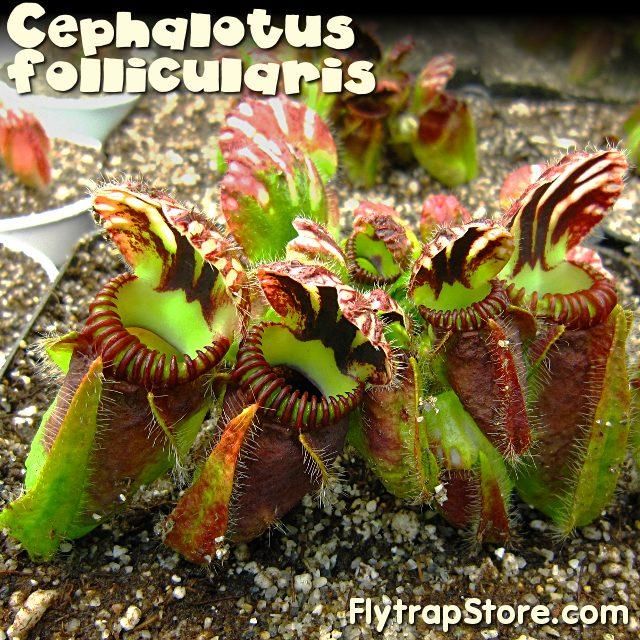Cephalotus
Cephalotus is a beautiful and unique carnivorous pitcher plant from Australia, splashed with striking patterns, red accents, and some almost transparent areas in the hoods of the pitchers. A valued addition to any carnivorous plant collection.
Please be aware that young Cephlaotus are extremely small plants without mature pitchers. Young Cephalotus are usually between one-half inch (small clump) and two inches (XXL clump) in total diameter. Potted plants are shipped in our preferred potting medium of 50% peat and 50% 12-grit silica sand, topped with 12-grit silica sand. The sand is very heavy and thus Cephalotus cost a little more to ship than our other potted plants.
Please be aware that young Cephlaotus are extremely small plants without mature pitchers. Young Cephalotus are usually between one-half inch (small clump) and two inches (XXL clump) in total diameter. Potted plants are shipped in our preferred potting medium of 50% peat and 50% 12-grit silica sand, topped with 12-grit silica sand. The sand is very heavy and thus Cephalotus cost a little more to ship than our other potted plants.
Availability:
Out of stock
SKU
cephalotus
Cephalotus follicularis, like Dionaea muscipula (the Venus flytrap), is the only species in its genus, a unique plant very different from any other pitcher plant in the world. Native to just a small coastal area of southwestern Australia, Cephalotus follicularis with its bizarrely shaped and very colorful pitcher-shaped leaves is prized by growers and collectors of carnivorous plants all over the world.
Be sure to read the FlytrapStore Cephalotus care guide before ordering!
Cephalotus is a conservative-growing plant, meaning that they usually concentrate on the support structure (the roots) more than the leafy growth, at least until they are fairly mature, which can take 1 and a half or 2 years. The plant puts a lot of its energy into forming a very dense, multi-branched root system, and then puts out growth in surprising spurts as its root system can accommodate it.
However, Cephalotus are notoriously balky about being disturbed and may sulk and not grow much for a few weeks after transplanting or shipping. This adjustment period in which Cephalotus attempts to become comfortable in its new conditions can last from 2-3 weeks up to perhaps 6-8 weeks.
When fully mature, after a couple of years or so, a healthy Cephalotus will produce pitchers often 2-3 inches from the bottom of the pitcher to the top of the open pitcher lid. But they do require time, patience, and good care to reach their full potential.
Be sure to read the FlytrapStore Cephalotus care guide before ordering!
Important Information about Cephalotus
If you are unfamiliar with Cephalotus, they are relatively small plants. The young plants can have pitchers no more than 1/4 inch for months before growing a fully-formed adult-shaped pitcher that is perhaps 2-3 times as large as the tiny juvenile pitchers but still perhaps only 1/2 to 3/4 inch.Cephalotus is a conservative-growing plant, meaning that they usually concentrate on the support structure (the roots) more than the leafy growth, at least until they are fairly mature, which can take 1 and a half or 2 years. The plant puts a lot of its energy into forming a very dense, multi-branched root system, and then puts out growth in surprising spurts as its root system can accommodate it.
However, Cephalotus are notoriously balky about being disturbed and may sulk and not grow much for a few weeks after transplanting or shipping. This adjustment period in which Cephalotus attempts to become comfortable in its new conditions can last from 2-3 weeks up to perhaps 6-8 weeks.
When fully mature, after a couple of years or so, a healthy Cephalotus will produce pitchers often 2-3 inches from the bottom of the pitcher to the top of the open pitcher lid. But they do require time, patience, and good care to reach their full potential.
Write Your Own Review






